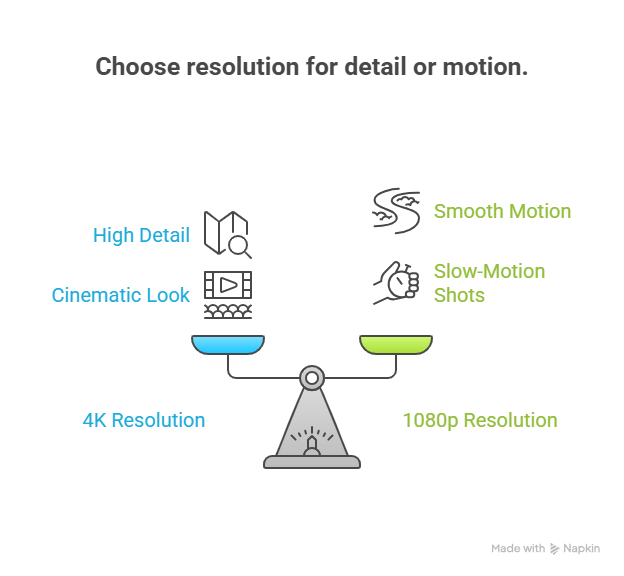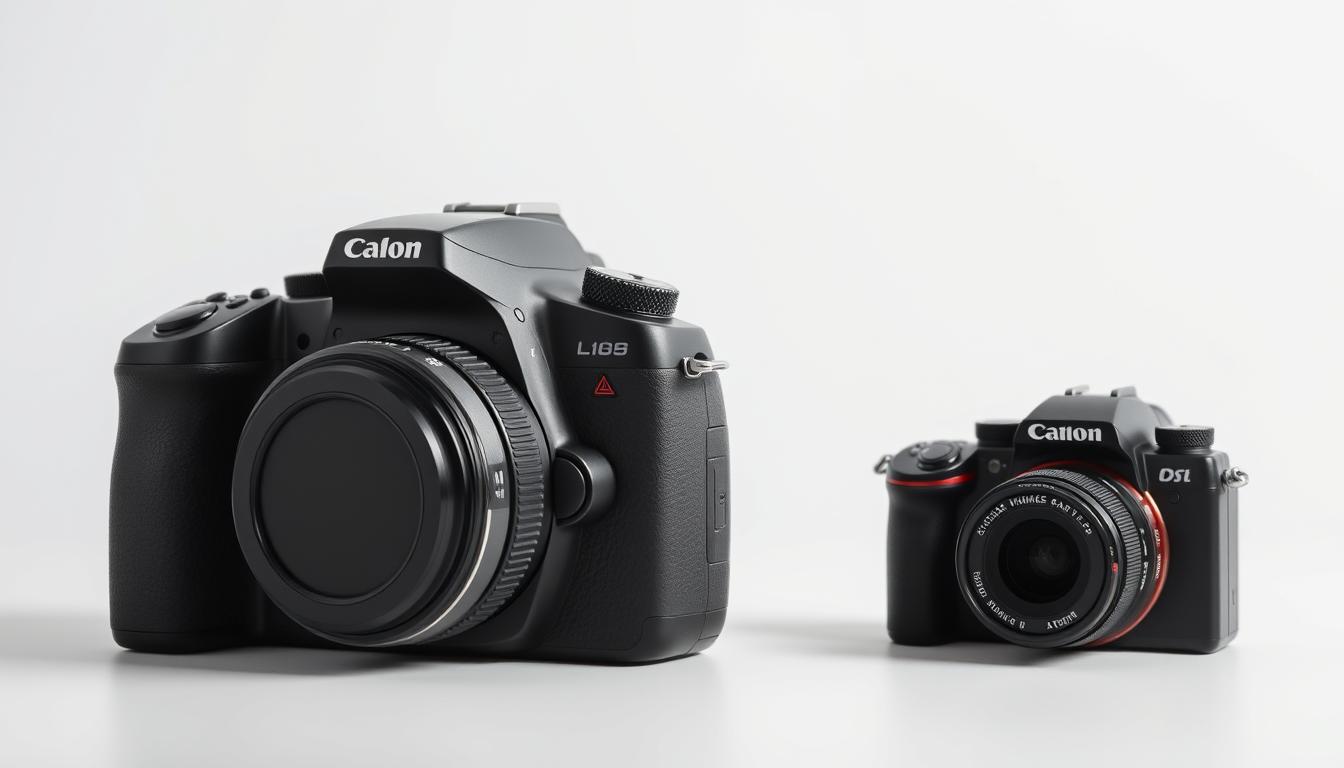The world of vlogging is booming, with millions of creators sharing their experiences and stories online. As the demand for high-quality content grows, so does the importance of choosing the right camera. In 2025, vloggers are faced with a crucial decision: should they opt for a DSLR or a mirrorless camera?
Both options have their advantages and disadvantages. DSLRs are known for their optical viewfinders and wide lens compatibility, while mirrorless cameras offer compact designs and advanced autofocus features. As we dive into the world of vlogging cameras, it’s essential to understand what makes each type tick.
Choosing the best camera for vlogging can be overwhelming, but our comparison aims to simplify the process. We’ll explore the key differences between DSLR and mirrorless cameras, helping you make an informed decision for your vlogging needs in 2025.
DSLR vs Mirrorless for Vlogging: Core Differences in 2025
The choice between DSLR and mirrorless cameras for vlogging in 2025 hinges on several key factors that can make or break your vlogging experience. Understanding these differences is crucial for content creators aiming to produce high-quality videos.
Size, Weight, and Portability Factors
One of the most significant advantages of mirrorless cameras over DSLRs is their size, weight, and portability. Mirrorless cameras are generally more compact and lighter, making them easier to carry around, especially for vloggers who are always on the move. This portability is a game-changer for those who need to travel light without compromising on camera quality.
Here are some key points to consider regarding size, weight, and portability:
- Mirrorless cameras tend to be more compact due to the absence of a mirror and prism system.
- DSLRs, while bulkier, offer a more traditional handling experience that some vloggers prefer.
- The weight of DSLRs can be a drawback for long shooting sessions or when traveling.
Battery Life and Operational Efficiency
Battery life is another critical factor for vloggers, who often record for extended periods. DSLRs typically have longer battery life due to their optical viewfinder, which consumes less power compared to the electronic viewfinders or LCD screens used in mirrorless cameras.
However, advancements in technology have significantly improved the battery life of mirrorless cameras. Some models now offer extended recording times, making them more viable for long vlogging sessions.
Key considerations for battery life include:
- The type of viewfinder used (optical vs. electronic).
- The camera’s power-saving features, such as automatic shutdown or low-power modes.
- External power options, like battery grips or portable chargers.
Autofocus and Tracking Performance
Autofocus and tracking performance are vital for capturing sharp, in-focus footage, especially when moving or tracking subjects. Mirrorless cameras generally excel in this area, thanks to their advanced autofocus systems and faster processing capabilities.
Some of the advanced autofocus features in mirrorless cameras include:
- Phase-detection autofocus for faster and more accurate focusing.
- Eye-tracking and face-detection capabilities for improved subject tracking.
- Customizable autofocus settings to suit different vlogging styles.
In conclusion, the core differences between DSLR and mirrorless cameras for vlogging in 2025 revolve around size and portability, battery life, and autofocus performance. By understanding these factors, vloggers can make informed decisions about which type of camera best suits their needs and enhances their vlogging experience.
Essential Vlogging Features to Consider When Choosing Your Camera
For vloggers, the camera is their tool of trade, and understanding its essential features is key to producing top-notch content. When selecting a camera for vlogging, several critical factors come into play.
Video Resolution and Frame Rate Options
The quality of your video is paramount, and this is largely determined by the camera’s resolution and frame rate capabilities. 4K resolution is now a standard for high-quality vlogging, offering a more detailed and cinematic look. However, it’s not just about resolution; the ability to shoot at various frame rates is equally important. Higher frame rates, such as 60fps or 120fps, allow for smoother footage and better slow-motion effects.
When evaluating a camera’s video capabilities, consider whether it can shoot in LOG format, which provides a wider dynamic range and more flexibility during post-production editing.
| Resolution | Frame Rate Options | Benefits for Vlogging |
|---|---|---|
| 4K | Up to 60fps | High detail, smooth motion |
| 1080p | Up to 120fps | Ideal for slow-motion shots |

Audio Quality and Microphone Connectivity
While video quality is crucial, good audio quality is equally important for a professional vlogging experience. Cameras with good built-in microphones can significantly enhance your vlogs. However, for superior audio, consider cameras that offer external microphone connectivity, such as a 3.5mm jack or support for professional XLR microphones.
Some cameras also offer advanced audio features like wind noise reduction and manual audio level control, which can be very beneficial for vloggers shooting in various environments.
Connectivity, Streaming, and Mobile Integration
In today’s connected world, the ability to easily share your vlogs is crucial. Cameras with advanced connectivity options such as Wi-Fi, Bluetooth, and USB-C can simplify the process of transferring files to your smartphone or directly streaming to social media platforms.
Additionally, cameras that offer mobile app integration can enhance your vlogging experience by allowing you to monitor your camera remotely, adjust settings, and even use your smartphone as an additional monitor.
| Connectivity Feature | Benefit for Vloggers |
|---|---|
| Wi-Fi/Bluetooth | Easy file transfer and remote camera control |
| USB-C | Fast file transfer to computers |
| Mobile App Integration | Enhanced control and monitoring |
By carefully considering these essential features, vloggers can choose a camera that not only meets their current needs but also adapts to their future vlogging ambitions.
Conclusion
When deciding between DSLR and mirrorless cameras for vlogging, several key factors come into play. The core differences lie in their size, weight, battery life, autofocus, and video capabilities.
Mirrorless cameras offer superior portability and advanced autofocus features, making them highly suitable for vlogging. Their ability to provide real-time tracking and preview enhances the overall vlogging experience.
On the other hand, DSLR cameras have their strengths, particularly in terms of battery life and optical viewfinder capabilities. However, their bulkier design can be a drawback for vloggers seeking a more discreet and portable option.
Ultimately, the best camera for vlogging is one that balances your needs for video quality, portability, and operational efficiency. For most vloggers, a mirrorless camera is the preferred choice due to its versatility and advanced features. When choosing your camera, consider the essential vlogging features such as video resolution, audio quality, and connectivity options to ensure a seamless vlogging experience.
By weighing the pros and cons of DSLR vs mirrorless for vlogging, you can make an informed decision and select the best camera that suits your vlogging style and requirements.
FAQ
What are the key differences between DSLR and mirrorless cameras for vlogging?
The main differences lie in their size, weight, battery life, autofocus, and overall functionality. Mirrorless cameras are generally more compact and have faster autofocus, while DSLRs have longer battery life.
Which camera type is more suitable for beginners in vlogging?
Mirrorless cameras are often recommended for beginners due to their ease of use, compact size, and advanced features like autofocus and video stabilization.
How important is video resolution for vlogging, and what should I look for?
Video resolution is crucial for vlogging as it affects the quality of your footage. Look for cameras that can record at least 4K resolution at 30fps or higher for smooth and detailed video.
Can I use external microphones with both DSLR and mirrorless cameras?
Yes, both DSLR and mirrorless cameras often have microphone inputs, allowing you to connect external microphones for better audio quality.
What is the significance of autofocus and tracking performance in vlogging cameras?
Autofocus and tracking performance are vital for capturing sharp footage, especially when moving or tracking subjects. Cameras with advanced autofocus systems can significantly improve the quality of your vlogs.
Are there any specific connectivity features I should look for in a vlogging camera?
Yes, features like Wi-Fi, Bluetooth, and USB-C connectivity can enhance your vlogging experience by allowing for easy file transfer, remote camera control, and live streaming.
How does battery life impact vlogging, and which camera type has better battery life?
Battery life is critical for vlogging, especially during long shoots or when you’re away from a power source. DSLRs generally have longer battery life compared to mirrorless cameras, although this can vary depending on the model.
Can I livestream directly from my camera, and what are the requirements for doing so?
Many modern cameras, especially mirrorless ones, support livestreaming via HDMI output or Wi-Fi connectivity. Check your camera’s specifications for livestreaming capabilities and the required equipment.

